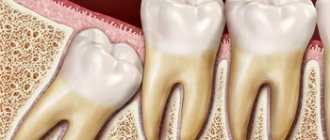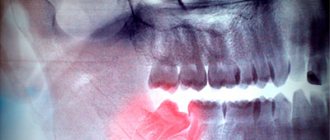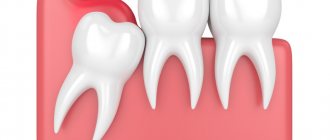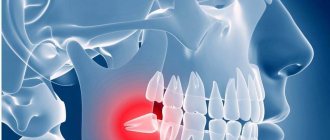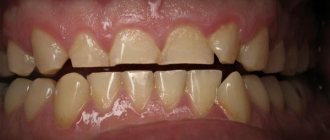Reasons for the abnormal location of the unit
In dentistry, wisdom teeth are called third (last) molars. Their eruption is noted at the age of 17-25 years. The given figures are arbitrary; in some patients this condition is observed at an earlier or later age. In many adult patients, the figure eights remain retracted and do not appear on the gum surface.
It should be noted the main factors that lead to wisdom teeth growing into the cheek:
- pathologies of intrauterine development;
- malnutrition in infancy and childhood;
- severe infectious diseases;
- chronic systemic diseases;
- abnormalities in the structure of the jaw caused by external (trauma) or internal abnormalities in the body;
- incorrect location of the rudiments of eights (diagonally or horizontally);
- too hard or soft gum tissue;
- large unit crowns.
The main cause of the problem is a violation of the formation of the fetus in the prenatal period, despite the fact that the last molars appear on the surface in adulthood.
If a child has problems with the eruption of milk elements, then most likely the wisdom teeth will grow crooked
Another common cause of pathology is the incorrect location of the molar buds. In this case, the crown cuts into the cheek or grows into the adjacent tooth. Each of the listed cases requires removal of the problematic element, otherwise it threatens the development of serious problems.
When the unit is tilted towards the cheek, permanent injury to the soft tissue occurs. Benign tumor cells, which arise as a result of friction of the crown against the mucous membranes, degenerate into oncological structures. When a wisdom tooth deviates towards the seven, the root system of several elements is destroyed. In addition, the described condition increases the risk of enamel caries.
Retracted wisdom teeth are a problem for modern people, associated with a decrease in the size of the jaw due to a decrease in the chewing load on them. The problem affects people with malocclusions and patients with healthy row elements. If the last filler does not have enough space during the eruption process, then the wisdom tooth grows incorrectly, making its way to the surface of the gum.
Recovery period
How long does recovery take after removal of upper wisdom teeth and what limitations does it impose? In most cases, after 1-2 days the patient returns to normal life, but sometimes recovery takes longer. To prevent the rehabilitation period from being prolonged, it is very important to follow the doctor’s recommendations:
- take prescribed antibiotics, painkillers and anti-inflammatory drugs;
- do not visit the bathhouse, sauna, swimming pool, or take a bath;
- follow a diet, if possible, eat only soft foods;
- refrain from smoking.
If the doctor did not make mistakes during removal, and the patient carefully followed all the doctor’s recommendations, then the recovery period will pass quickly, and the problem of the upper “eights” can be forgotten forever.
Symptoms
In almost all cases, the eruption of the third molar is accompanied by pain. The problem is due to the fact that these elements have no predecessors and they have to make their way to the surface through a thick layer of soft tissue. Minor signs of discomfort are not a reason to panic, but a person should pay closer attention to the problem area.
Photo of a retracted wisdom tooth
Pathology of wisdom tooth growth is determined by the following characteristic symptoms:
- increased bleeding of gums;
- tumors of the gums and cheeks;
- severe pain when chewing food;
- swelling extending to the tongue and throat;
- severe inflammation of the gums in the area of the erupting element and the adjacent tooth;
- discomfort when swallowing;
- injury to the mucous membranes of the inside of the cheek;
- periodic headaches.
An increase in body temperature is less common if the wisdom tooth grows sideways. Relief of this symptom is carried out with the help of painkillers and antipyretic drugs. The eruption of the figure eight can be observed for several years, which entails numerous dental complications. If you experience prolonged discomfort, do not delay visiting your doctor.
Each of the symptoms of the problem should be considered in more detail. One of the most common signs of pathology is swelling and swelling of the gums. Swelling appears even if the wisdom tooth grows in the vertical (correct) direction. Inflammation is due to the fact that the crown makes its way to the surface and injures the soft tissues. Due to injury, the gums increase slightly in size and swell.
The symptom is aggravated if the wisdom tooth grows into the cheek or towards an adjacent element. The element cannot cut through normally due to the peculiarities of its position. As a result, it puts a lot of pressure on the gums, which become swollen, swollen and painful. Along with the gums, the inside of the cheek often swells. You can learn more about the signs of wisdom tooth eruption from this article.
Another sign of abnormal growth of a wisdom tooth is increased bleeding of soft tissues.
Bleeding gums are typical for the horizontal position of the last molars, since in this case the tooth severely injures the gums, cheek, or rests on the seven. The condition is dangerous due to the development of more serious complications - phlegmon, abscess, periostitis, deformation of the bone tissue of the jaw.
Regular friction of the crown of the retained element against the gum tissue leads to the fact that the wounds do not have time to heal and regularly bleed. The symptom is also typical for those situations when the unit erupts towards the tongue. If bleeding occurs in the soft tissues of the mouth, you should immediately consult a doctor.
A crooked tooth can give rise to fever. The symptom is also observed in infants during the growth of primary incisors. In adults, the immune system is more developed, so signs of body hyperthermia during the eruption of figure eights are often absent.
A strong jump in temperature occurs for several reasons:
- Physiological. The body reacts to soft tissue damage.
- Infectious. The symptom signals the proliferation of pathogenic flora in the hood of the wisdom tooth.
In the first case, the patient’s condition stabilizes on its own after a few days. You can relieve the symptoms of the problem with painkillers. The second reason requires professional help, undergoing a set of diagnostic measures and taking antibiotics.
A growing wisdom tooth causes pain when chewing. Discomfort appears at the moment when the rudiment leaves the bone tissue of the jaw and reaches the edge of the gum
When the figure eight tooth is in a horizontal or diagonal position, the signs of pain when eating food become more intense. The pain radiates to the ears, temples or to the lymph nodes. In most cases, there is constant dull or sharp pain.
If you have to resort to potent drugs to relieve symptoms, it is better to consult a doctor. Regular use of such medications negatively affects the condition of the gastrointestinal tract. Treatment with drugs with a powerful therapeutic effect is possible only after consultation with a doctor.
Emergency measures at home
It is not always possible to get an appointment with a dentist when the first painful signs appear. You can relieve discomfort at home. The main goal of emergency measures is to relieve irritation of mucous structures and accelerate wound regeneration.
What to do when wisdom teeth erupt? For this purpose, you can use simple folk recipes:
What to do if you have a headache after wisdom tooth removal
- Rinse with baking soda solution: 1 tsp. funds for 1 glass of water. The medicine kills pathogenic flora in the mouth and prevents the development of complications associated with cheek injury.
- Decoction of sage and oak bark: 5 tbsp. Both ingredients are poured into 0.5 liters of boiling water and left to cool. Rinse your mouth with the decoction 6-8 times a day. Plants relieve swelling and inflammation from the problem area, reduce the intensity of pain and itching. Oak bark and sage promote the death of pathogenic microorganisms and accelerate the healing of a sore cheek.
- Turnip decoction: 3 tbsp. chopped vegetable, pour a glass of water and simmer over low heat for 15 minutes. Rinse your mouth with the product every emergency.
- Salt solution. The product is used for severe inflammation of soft tissues and swelling. The solution is prepared according to the same recipe as soda, only salt is added to the water. The medicine can be used an unlimited number of times.
- Sea buckthorn oil. Effective in cases where a tooth scratches the cheek. The product has a powerful regenerating effect and quickly restores the structure of damaged tissues.
- Melissa tincture: 2 tbsp. leaves, pour 500 ml of boiling water and leave to infuse for 4 hours. The product is used to rinse the mouth 4 times a day. The plant has antimicrobial and anti-inflammatory effects.
If traditional medicine recipes do not give the desired effect, then turn to medications for help:
- To eliminate intense pain in the gums and teeth, use Nise, Nurofen or Ketorol. These drugs are available without a doctor's prescription, but you should not get carried away with taking them. The maximum allowable time for self-therapy is 3-5 days. Otherwise, you may get used to the components of the product, and it will stop helping. Another side effect of uncontrolled use of anti-inflammatory drugs is intoxication of the body.
- For severe pain, you can use Etoricoxib in the amount of 1 tablet per day. The effect of taking the drug lasts much longer than from Nise or Nurofen. In addition to pain relief, the medication has a powerful anti-inflammatory effect.
- Antiseptic treatment of the oral cavity is carried out using the drugs Chlorhexidine, Chlorophyllipt, Miramistin or Angilex. The procedure is repeated at least 4 times a day at equal intervals.
- Locally, the problem area is treated with combined action gels - Kamistad. Holisalom. They reduce pain and relieve signs of inflammation. The disadvantage of drugs is a short period of action (up to 1 hour) and the possibility of developing allergic reactions.
The main active ingredient in anesthetic gels is lidocaine.
You should consult a dentist even when relief is observed from emergency measures. The fact is that the problem does not disappear on its own, but only its symptoms are relieved for a while. Manifestations of the pathology will be observed until the doctor eliminates its underlying cause. A person will not be able to independently adjust the height of a figure eight.
How can I determine if I need to have my wisdom tooth removed?
A qualified dentist can determine the need to remove “controversial” eighth teeth after a series of diagnostic procedures (examination of the oral cavity, analysis of radiographs, functional analysis). Go to our doctors.
By clicking on the “Make an appointment” button, I consent to the processing of my personal data.
I have read and agree with the conditions for processing personal data set out on the website ds-chocolate.ru.
Consent to the processing of personal data
Dental care
The most common way to solve the problem associated with improper growth of the last molar is to remove the unit. Before making a final decision, the doctor sends the patient for an x-ray. The picture determines the direction of the figure eight, the state of its roots and its location relative to other elements of the row. After this, the doctor determines the appropriate anesthetic agent.
The wisdom tooth is usually removed from the mouth using local anesthesia
Rarely, general anesthesia is used before surgery, for example, if the tooth has not fully grown and complex surgery is required. The doctor monitors the patient's condition during and after anesthesia.
In order to gain access to the retracted element, the doctor has to cut out soft tissue. This allows you to gain free access to the root system of the element. In some cases, surgery is performed to remove the bone tissue around the root of the wisdom tooth.
The operation is also carried out with sawing of the septum if the roots are removed one by one. If the teeth have grown completely, then the doctor chooses the tactic of simple removal. The last molar is removed from the oral cavity using special dental forceps. The resulting wound must be treated with antiseptic solutions to prevent the spread of bacteria into the deep layers of the gums. The edges of the wound are closed with absorbable sutures. If heavy bleeding is observed after wisdom tooth removal, dentists use a hemostatic sponge.
The duration of the operation depends on the age of the patient and the characteristics of the eruption of the figure eight. In some cases it takes no more than 30 minutes, in others it can increase to 1.5-2 hours.
Possible complications after removal - and their differences from the norm
Three conditions are considered normal after surgery: pain, swelling and bleeding. Let us consider the characteristics of normal and pathological conditions in detail.
Pain in the intervention area
Painful sensations may persist for 2-3 days, and to get rid of them, you can take NSAIDs (Ibuprofen, for example) or any painkiller. If the pain intensifies or is poorly suppressed by analgesics, you should consult a doctor.
“When I first heard the name of the film “The Hateful Eight,” I thought that it was just about my long-suffering eight))) But, of course, I was the sufferer here. The eruption lasted for years, and the surgeon probably periodically opened the gum cap four times, until I decided that that’s enough, I’m waiting for Monday and going to ask for removal. They took an x-ray and scheduled surgery in 2 days. And, no matter how afraid I was, everything went perfectly - the injection froze the jaw longer than the removal itself lasted. I had to take sick leave, though, because on the first evening it felt as if a truck had driven into my jaw. But gradually everything returned to normal, the main thing is to listen carefully to what the doctor advises while the wound heals.”
Valentina88, review from otzovik.com
The appearance of swelling and hematoma on the cheek
Swelling can also last for two days. As a rule, it subsides as soon as blood circulation in the injured area improves. If the swelling increases, the temperature rises, or other signs of inflammation appear, then you need to urgently go to the dental clinic. A hematoma (or bruise) on the cheek appears on the 2nd day after complex removal and can persist for up to 7-14 days, gradually turning pale.
Bleeding from the wound
Bleeding after removal is a natural protective reaction of the body. As a rule, within 2-3 hours after surgery, a blood clot forms and closes the socket. After this, the bleeding either stops altogether or remains in the form of so-called ichor for several more hours. If light bleeding continues a day later or within 3-4 hours after removal heavy bleeding persists, then this is a reason to seek medical help.
What does the appearance of pus and temperature indicate?
If purulent discharge appears around the hole, if the body temperature rises to 38 degrees, pain from the removal site begins to spread to the eye, ear, neck, nose, signs of intoxication appear (headache and muscle pain, weakness, dizziness, etc.) These are signs of a developing complication. A quick visit to the dentist will avoid their negative consequences.
Prohibited actions
Any oral medications are allowed to be taken for no more than 3-4 days, regardless of the strength of the therapeutic effect. Do not heat or rinse the damaged area with hot solutions. High temperature increases the rate of reproduction of pathogenic flora. After the procedure, swelling usually increases, and signs of inflammation become more pronounced.
It is forbidden to apply folk remedies with an aggressive composition to damaged mucous membranes: alcohol compresses, onions, garlic, lemon. Such actions negatively affect the process of soft tissue regeneration
Consequences of untimely intervention
If the wisdom tooth is bent towards the cheek, then the symptoms of the pathology periodically subside and worsen again. If there is untimely intervention, the situation can have more serious consequences, which will take a lot of time and effort for treatment.
The first consequence of the problem is the destruction of the roots of neighboring elements. As a result, the doctor will have to amputate not one, but several elements located in the vicinity of the removed unit. Other consequences of improper eruption of the third molar include:
- irreversible damage to the bone structures of the jaw;
- microscopic rupture of cheek tissue;
- pericoronitis;
- periostitis;
- inflammation of the submandibular lymph nodes;
- changes in the structure of the cheek and gums.
Scars form on the inner surface of the cheek, which are noticeable upon palpation. Over time, this process can be complicated by the degeneration of abnormal tissues into malignant cells. The situation requires immediate surgical intervention or a comprehensive medical approach.
Features of tooth extraction in the upper jaw
Unlike lower “eights,” upper wisdom teeth are considered less problematic. They tend to grow straighter, have less retention, and rarely have roots that are bent, twisted, or excessively long. The bone of the upper jaw is not so massive and dense, there are fewer blood vessels in the soft tissues, and the likelihood of hitting the trigeminal nerve is lower. Therefore, the upper wisdom teeth rarely have to be removed, and if it comes to surgery, it is easier than removing the lower wisdom tooth.
